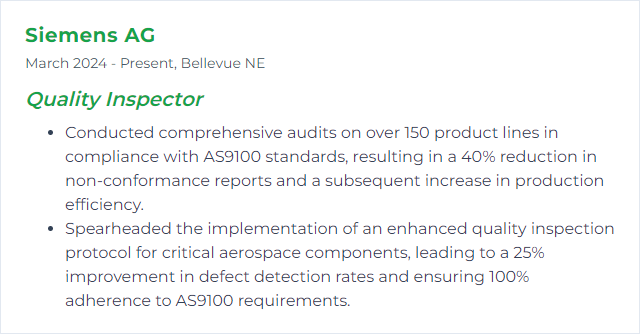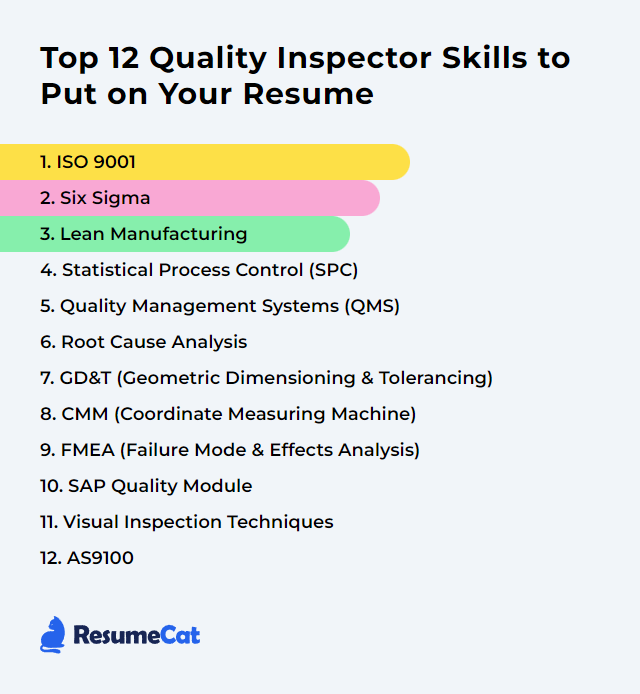Top 12 Quality Inspector Skills to Put on Your Resume
Hiring teams skim fast and judge faster. A quality inspector who can show sharp, relevant skills on a resume will be remembered. Put real capability on display—proof you can hold the line on standards, keep processes in control, and move problems off the floor before they become defects.
Quality Inspector Skills
- ISO 9001
- Six Sigma
- Lean Manufacturing
- Statistical Process Control (SPC)
- Quality Management Systems (QMS)
- Root Cause Analysis
- GD&T (Geometric Dimensioning and Tolerancing)
- CMM (Coordinate Measuring Machine)
- FMEA (Failure Mode and Effects Analysis)
- SAP Quality Module
- Visual Inspection Techniques
- AS9100
1. ISO 9001
ISO 9001 is the global benchmark for quality management systems. It lays out how an organization plans, controls, measures, and improves processes so products and services consistently meet customer and regulatory requirements. For inspectors, it’s the backbone—clear criteria, documented evidence, and disciplined follow-through.
Why It's Important
It anchors consistency. It aligns teams on requirements. It drives corrective action and continual improvement. A quality inspector uses ISO 9001 to verify compliance, spot drift, and keep customer satisfaction from slipping.
How to Improve ISO 9001 Skills
- Audit with intent: Run internal audits against process and product requirements using ISO 19011 guidance. Turn findings into prioritized actions.
- Elevate performance evaluation: Apply ISO 9001:2015 Clause 9 thinking—track KPIs, monitor process capability, and review customer feedback routinely.
- Close the loop fast: Use Clause 10 improvement practices. Contain, correct, and prevent recurrence. Document objective evidence.
- Keep competencies sharp: Train inspectors and operators on standards, specs, and inspection methods. Refresh annually or when processes change.
- Work the toolbox: Apply 5S, Kaizen, and Six Sigma basics to remove waste, reduce variation, and simplify checks.
- Document what matters: Maintain clear procedures, records, and change history so audits are straightforward and trends are traceable.
How to Display ISO 9001 Skills on Your Resume
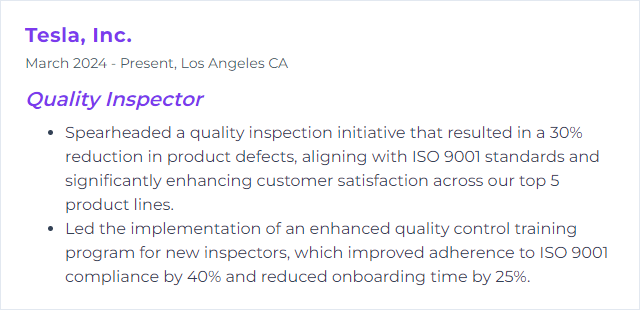
2. Six Sigma
Six Sigma is a data-first approach to crush defects and control variation. Inspectors use its tools to measure, analyze, and steady a process so what ships is predictable and right the first time.
Why It's Important
It cuts scrap. It stabilizes output. It boosts reliability customers notice. Less firefighting, more repeatable results.
How to Improve Six Sigma Skills
- Advance your belt: Build rigor through Green Belt or Black Belt training. Projects matter—apply concepts on the floor.
- Lean on DMAIC: Define clearly, measure precisely, analyze root causes, improve with trials, control with charts and standard work.
- Use the classics well: Fishbone diagrams, control charts, FMEA, capability studies. Depth beats novelty.
- Blend Lean and Six Sigma: Eliminate waste while reducing variation. Faster flow, fewer defects.
- Stay current: Follow reputable quality bodies and communities. Then test ideas in your process and keep what works.
How to Display Six Sigma Skills on Your Resume
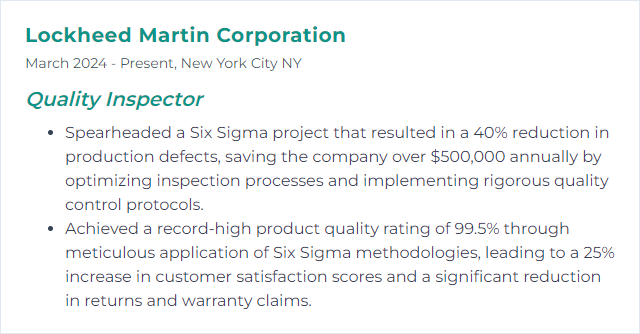
3. Lean Manufacturing
Lean Manufacturing relentlessly removes waste—waiting, rework, motion, overproduction—so value moves without friction. Inspectors gain clearer processes, fewer defects, and cleaner handoffs.
Why It's Important
Less waste means fewer opportunities for error. Better flow means steadier quality. Inspections become targeted instead of bloated.
How to Improve Lean Manufacturing Skills
- Kaizen daily: Small fixes, relentlessly applied. Teach teams to see waste and act.
- Design out mistakes: Use poka‑yoke to prevent slips before they happen.
- Map the value stream: Expose bottlenecks and non‑value steps. Trim, combine, or automate.
- Build a quality culture: Everyone owns quality. Quick feedback loops. Visual controls. Clear standards.
- Measure the process: Apply SPC to watch stability and drift. React before defects grow.
- Dig into causes: Use the 5 Whys (and verify with data) to stop recurrence.
How to Display Lean Manufacturing Skills on Your Resume
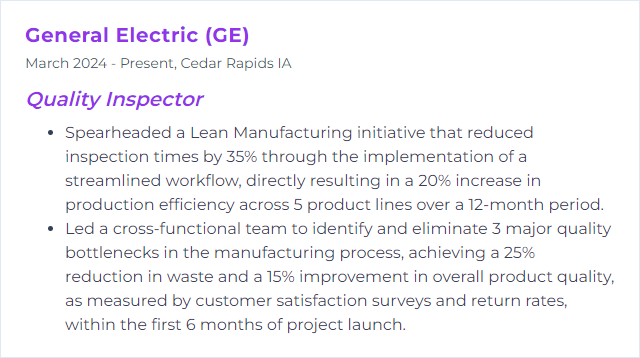
4. Statistical Process Control (SPC)
SPC tracks process behavior with statistics—control charts, capability metrics, alarms—so variation stays inside the lines and surprises stay off the dock.
Why It's Important
It exposes special causes early, reduces defects, and sustains predictable performance. Inspectors move from reacting to preventing.
How to Improve Statistical Process Control (SPC) Skills
- Master the fundamentals: Know which chart to use and why. Understand rational subgrouping, control limits, and signals.
- Collect clean data: Calibrated gauges, clear sampling plans, consistent operators. Garbage in, garbage out.
- Use strong tools: Software such as Minitab or SPC-focused add‑ins speeds analysis and visualization.
- Monitor routinely: Review charts at the line, not just in reports. Act on signals the same shift.
- Improve iteratively: Kaizen your way from noisy to stable. Lock in gains with standard work and training.
- Collaborate: Share findings with production, maintenance, and engineering so fixes stick.
- Revisit as processes change: New materials, machines, or methods require fresh baselines and limits.
How to Display Statistical Process Control (SPC) Skills on Your Resume

5. Quality Management Systems (QMS)
A QMS is the framework of policies, procedures, roles, and records that keeps quality systematic and auditable. Inspectors live in this structure—criteria defined, checks performed, evidence captured, improvements verified.
Why It's Important
It ensures products meet requirements, processes stay under control, and compliance is demonstrable. It also accelerates problem solving and accountability.
How to Improve Quality Management Systems (QMS) Skills
- Know the standards: Understand ISO 9001 requirements and how they translate to your processes and records.
- Develop skills continuously: Training on inspection methods, risk‑based thinking, and document control keeps the system healthy.
- Audit with purpose: Plan internal audits to reveal gaps, redundancies, and risks—not just to check boxes.
- Digitize wisely: QMS software can streamline document control, NC/CAPA tracking, and KPI dashboards.
- Champion quality culture: Align goals, encourage feedback, and reward prevention over heroics.
- Listen to customers: Feed complaints and compliments into corrective actions and design tweaks.
- Benchmark: Compare practices with industry leaders and adopt proven methods.
How to Display Quality Management Systems (QMS) Skills on Your Resume

6. Root Cause Analysis
Root Cause Analysis (RCA) digs beneath symptoms to the true cause, then fixes the system so the issue doesn’t loop back.
Why It's Important
It prevents repeat defects, cuts cost of poor quality, and builds resilient processes. Inspectors become problem eliminators, not just problem spotters.
How to Improve Root Cause Analysis Skills
- Frame the problem tightly: Clear scope, facts only, measurable impact.
- Gather the evidence: Time, location, occurrence patterns, conditions, and verified data.
- Generate causes: Use 5 Whys and fishbone diagrams, but validate each suspected cause with data or experiments.
- Confirm the root: Prove cause‑effect with tests or controlled trials.
- Act decisively: Define corrective and preventive actions, owners, and due dates.
- Verify effectiveness: Monitor post‑implementation results; adjust if signals persist.
- Capture learning: Update control plans, work instructions, and training so fixes endure.
Structured methods such as 8D can help teams move from containment to permanent correction.
How to Display Root Cause Analysis Skills on Your Resume
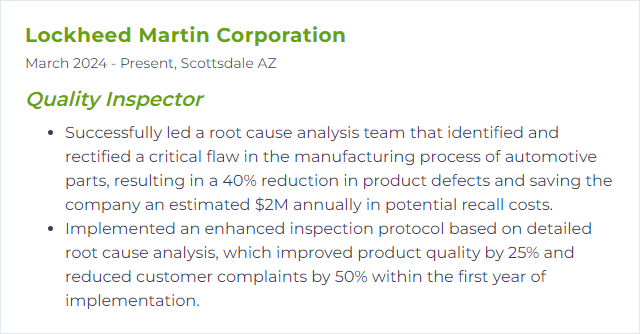
7. GD&T (Geometric Dimensioning and Tolerancing)
GD&T communicates allowable variation with symbols tied to function—form, orientation, location, and runout. Inspectors use it to interpret drawings correctly and verify parts will assemble and perform as intended.
Why It's Important
It removes ambiguity. It tightens fit and function across suppliers and processes. It keeps measurement aligned with design intent.
How to Improve GD&T (Geometric Dimensioning and Tolerancing) Skills
- Study the standard: ASME Y14.5 is the reference. Learn datum schemes, material modifiers, and tolerance zones.
- Practice relentlessly: Read complex prints, create sample callouts, and measure real parts against them.
- Use the right metrology: Match methods to features—surface plates, height gages, indicators, vision systems, CMM, or portable arms.
- Seek feedback: Review your interpretations with design and manufacturing engineers.
- Stay updated: Standards evolve; refresh your knowledge periodically.
How to Display GD&T (Geometric Dimensioning and Tolerancing) Skills on Your Resume

8. CMM (Coordinate Measuring Machine)
A CMM measures part geometry using tactile or non‑contact probes to verify dimensional and geometric requirements. Precision that confirms conformance.
Why It's Important
It captures complex features and tight tolerances with traceable accuracy, raising confidence in acceptance decisions.
How to Improve CMM (Coordinate Measuring Machine) Skills
- Calibrate on schedule: Use traceable artifacts and follow documented procedures.
- Maintain the machine: Clean axes, check air bearings, inspect probes, and follow manufacturer guidance.
- Update software and methods: New algorithms and strategies improve speed and accuracy.
- Train operators deeply: Program creation, probing strategies, alignment schemes, uncertainty awareness.
- Control the environment: Stable temperature, humidity, vibration isolation, and proper part conditioning.
- Validate programs: Use GR&R and correlation checks to confirm measurement credibility.
How to Display CMM (Coordinate Measuring Machine) Skills on Your Resume
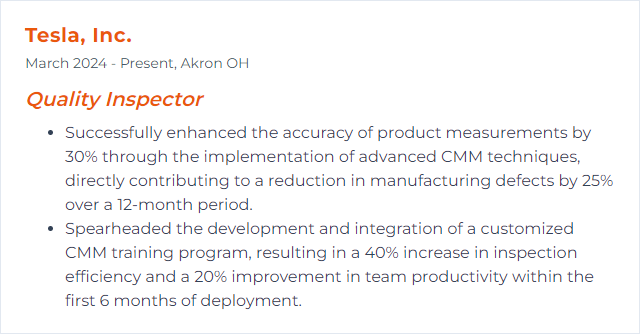
9. FMEA (Failure Mode and Effects Analysis)
FMEA identifies how a product or process might fail, estimates the risk, and drives preventive actions before failure reaches the customer.
Why It's Important
Done well, it prioritizes the right controls, reduces escapes, and strengthens reliability. Inspectors use it to align inspection and control plans with real risk.
How to Improve FMEA (Failure Mode and Effects Analysis) Skills
- Build a cross‑functional team: Design, manufacturing, quality, maintenance, and suppliers where relevant.
- Focus on failure effects: Start with what the customer experiences, then work back to causes and controls.
- Use the current standard: Follow the AIAG‑VDA approach and Action Priority (AP) for ranking, rather than relying solely on RPN.
- Keep it living: Update FMEAs with field data, process changes, nonconformances, and corrective actions.
- Connect to control plans: Translate high‑risk items into specific inspections, reaction plans, and error‑proofing.
- Leverage software when scale grows: Structured tools help with versioning, traceability, and collaboration.
How to Display FMEA (Failure Mode and Effects Analysis) Skills on Your Resume
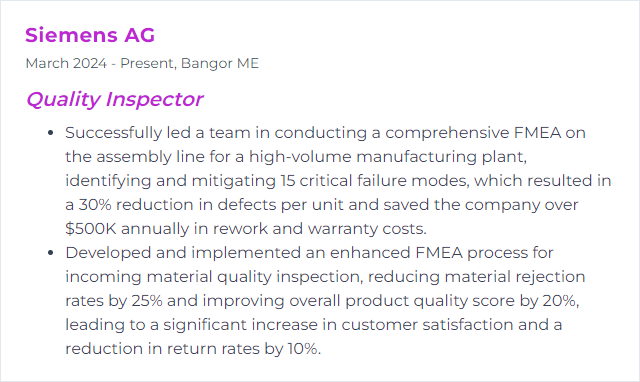
10. SAP Quality Module
SAP QM integrates quality planning, inspection, and control across procurement, production, and service. For inspectors, it centralizes inspection lots, results recording, usage decisions, and nonconformances.
Why It's Important
It embeds quality into the ERP fabric—fewer silos, better traceability, faster decisions, stronger compliance.
How to Improve SAP Quality Module Skills
- Clean master data: Inspection plans, characteristics, sampling procedures, and catalogs must be accurate and governed.
- Automate smartly: Auto‑create inspection lots, default results recording, and streamline usage decisions where rules are clear.
- Integrate modules: Tie QM to MM and PP so quality triggers and results flow without manual rework.
- Elevate analytics: Build dashboards for defects, trends, and supplier performance to act in real time.
- Invest in training: Inspectors and planners need hands‑on practice with transactions, variants, and reporting.
- Create a feedback loop: Gather user pain points and iterate configuration to remove friction.
How to Display SAP Quality Module Skills on Your Resume
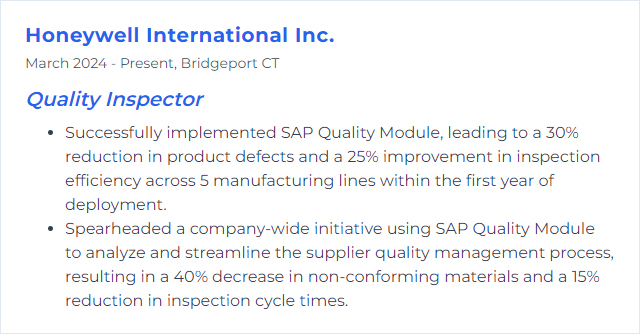
11. Visual Inspection Techniques
Visual inspection appraises surfaces, alignment, and obvious defects—by eye or with aids like magnifiers, borescopes, and vision systems—without tearing things apart.
Why It's Important
It’s fast, cost‑effective, and catches many issues early. Good technique prevents rework from snowballing.
How to Improve Visual Inspection Techniques Skills
- Light the scene: Proper illumination, color temperature, and contrast reveal flaws. Control glare and shadows.
- Use the right aids: Magnification, contrast dyes, mirrors, cameras, or digital vision where detail demands it.
- Standardize the method: Checklists, accept/reject samples, and clear defect definitions remove ambiguity.
- Train and qualify: Refresh skills to fight inspector fatigue and bias; certify where standards require.
- Augment with automation: Machine vision can catch repetitive or subtle defects and reduce variation between inspectors.
- Close the loop: Track misses and false calls; improve criteria, lighting, or aids based on evidence.
How to Display Visual Inspection Techniques Skills on Your Resume
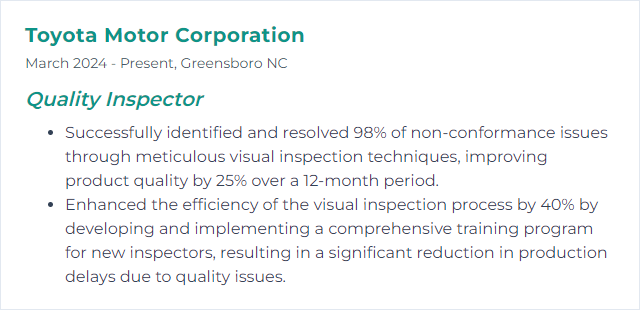
12. AS9100
AS9100 adds aerospace‑specific rigor on top of ISO 9001—configuration control, risk, special processes, and more. Inspectors in this space live by exacting requirements and airtight documentation.
Why It's Important
Safety, reliability, traceability. The stakes are unforgiving, and AS9100 keeps the system disciplined.
How to Improve AS9100 Skills
- Know AS9100D inside out: Focus on clauses affecting inspection, configuration management, risk, and product safety.
- Build robust inspection plans: Tie requirements to methods, sampling, measurement equipment, and reaction plans.
- Use CAPA effectively: Contain quickly, fix root causes, and verify effectiveness with hard evidence.
- Audit routinely: Internal audits against AS9100 and process‑based checklists reveal weak spots before customers do.
- Track KPIs: Escape rate, first‑time yield, turnaround time, and NC aging—metrics drive action.
- Manage suppliers tightly: Flow down requirements, monitor performance, and audit high‑risk processes.
- Apply AS9102 FAI where required: First Article Inspection proves the process can produce conforming parts, not just once, but repeatably.
- Pursue continual improvement: Lean, Six Sigma, and 8D methods raise the floor and ceiling.
How to Display AS9100 Skills on Your Resume
